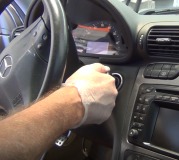This is what I know thus far: I recently bought this car cheap from the owner who claimed that there is an intermittent electrical? Mechanical? Problem. I drove this car for two weeks and thought that it drives very nice but just needed a tune-up. So I drove the car to a football game, came back after 45 minutes and the car would not start. It acted like it was just out of timing sequence. An occasional pop and a small backfire and then nothing.
Not being familiar with the car I went online looking for answers and I was lead astray by another online forum who obviously did not have a clue.
As I felt the engine needed a tuneup anyway, I went ahead and replaced the timing components, rebuilt the distributor, checked the compression, tested the fuel pressure, etc. In other words, I have eliminated any mechanical possibilities. My conclusion is that their is an anti-theft system involved with the ignition key or their is a short circuit in the wiring harness. After conferring with the local Chevy dealer repair. They confirmed the VATS and confirmed that part of the anitheft system is to turn off the injectors.
I have confirmed that the key pellet is good. I have confirmed that the two wires at the lock cylinder are good as I can get a reading down at the connector under the dash which is consistent with the ohms reading I get when I test the key.
This leads me to the next step which is to check the VATS module or possibly the wire or signal to the ECM.
I have done extensive research of this problem on the internet as I do not want to spend hundreds of dollars if there is a means to bypass the VATS system althogether. The dealership wants me to bring the car in but I don't feel I can justify paying 600.00 or more for Chevy's flaud engineering. I have read so many similar cases the last few days and I think this is a stupid system to have installed or designed. There should be a lot of frustrated people out there.
This is my first time dealing with this aspect of GM Engineering and I think it is absolutely ridiculous.
Is there a kit available to completely bypass the VATS module and allow the ECM to function without any hindrance. My son owns a 1990 Chevy Silverado pickup with a similar type engine except his vehicle does not employ the VATS and it runs reasonably well.
I will gladly make another donation if I receive a suitable answer to my question which helps me to satisfactorily resolve the problem. There are many answers out there which involve bypassing the pellet key and cylinder but I did not find anything regarding bypassing the VATS module altogether.
Access to wiring schematics and proven instructions would be great.
SPONSORED LINKS
Friday, January 2nd, 2009 AT 5:33 PM




